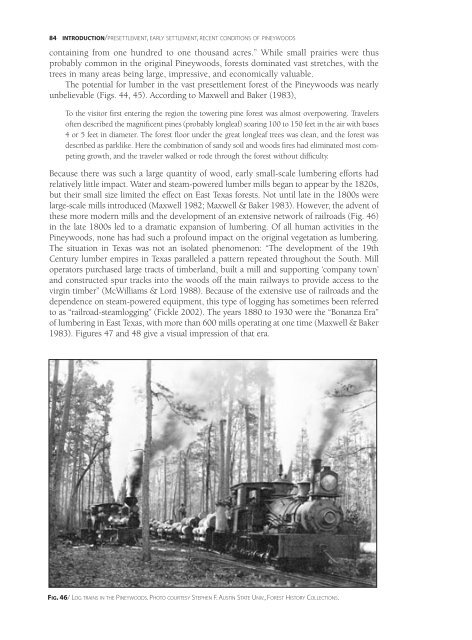ILLUSTRATED FLORA OF EAST TEXAS - Brit - Botanical Research ...
ILLUSTRATED FLORA OF EAST TEXAS - Brit - Botanical Research ...
ILLUSTRATED FLORA OF EAST TEXAS - Brit - Botanical Research ...
Create successful ePaper yourself
Turn your PDF publications into a flip-book with our unique Google optimized e-Paper software.
84 INTRODUCTION/PRESETTLEMENT, EARLY SETTLEMENT, RECENT CONDITIONS <strong>OF</strong> PINEYWOODS<br />
containing from one hundred to one thousand acres.” While small prairies were thus<br />
probably common in the original Pineywoods, forests dominated vast stretches, with the<br />
trees in many areas being large, impressive, and economically valuable.<br />
The potential for lumber in the vast presettlement forest of the Pineywoods was nearly<br />
unbelievable (Figs. 44, 45). According to Maxwell and Baker (1983),<br />
To the visitor first entering the region the towering pine forest was almost overpowering. Travelers<br />
often described the magnificent pines (probably longleaf) soaring 100 to 150 feet in the air with bases<br />
4 or 5 feet in diameter. The forest floor under the great longleaf trees was clean, and the forest was<br />
described as parklike. Here the combination of sandy soil and woods fires had eliminated most competing<br />
growth, and the traveler walked or rode through the forest without difficulty.<br />
Because there was such a large quantity of wood, early small-scale lumbering efforts had<br />
relatively little impact. Water and steam-powered lumber mills began to appear by the 1820s,<br />
but their small size limited the effect on East Texas forests. Not until late in the 1800s were<br />
large-scale mills introduced (Maxwell 1982; Maxwell & Baker 1983). However, the advent of<br />
these more modern mills and the development of an extensive network of railroads (Fig. 46)<br />
in the late 1800s led to a dramatic expansion of lumbering. Of all human activities in the<br />
Pineywoods, none has had such a profound impact on the original vegetation as lumbering.<br />
The situation in Texas was not an isolated phenomenon: “The development of the 19th<br />
Century lumber empires in Texas paralleled a pattern repeated throughout the South. Mill<br />
operators purchased large tracts of timberland, built a mill and supporting ‘company town’<br />
and constructed spur tracks into the woods off the main railways to provide access to the<br />
virgin timber” (McWilliams & Lord 1988). Because of the extensive use of railroads and the<br />
dependence on steam-powered equipment, this type of logging has sometimes been referred<br />
to as “railroad-steamlogging” (Fickle 2002). The years 1880 to 1930 were the “Bonanza Era”<br />
of lumbering in East Texas, with more than 600 mills operating at one time (Maxwell & Baker<br />
1983). Figures 47 and 48 give a visual impression of that era.<br />
FIG.46/ LOG TRAINS IN THE PINEYWOODS.PHOTO COURTESY STEPHEN F. AUSTIN STATE UNIV., FOREST HISTORY COLLECTIONS.
















